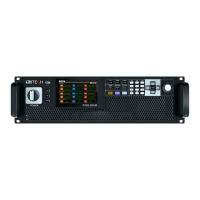Measurement Functions
Copyright ©ITECH Electronic Co., Ltd. 80
: Advanced configuration options for oscilloscope function.
⚫ Trigger source: Select trigger source, Voltage/Current and rise edge or fall
edge can be select.
⚫ Trigger mode: Auto and Normal can be select.
⚫ Print data: save the data
⚫ Line selection: Select the displayed curve, which is used to select whether
to display the voltage/current waveform of the corresponding phase. Up to
6 oscillographic data curves can be displayed.
U↑:Voltage trigger setting
Vertical calibration
The voltage range and current range are subject to vertical calibration
(voltage/scale and current/scale). Press the soft key [Function] and select Volt-
Range or Curr-Range. Rotate the knob to set the voltage or current range of
each interval.
Horizontal calibration
If the soft key [Function] is pressed and “Trig-TimeBase” is selected, you can
rotate the knob to adjust the horizontal scale (scanning speed). When the
horizontal (time/scale) setting is changed by rotating the knob, you can observe
the change of time/scale on the screen. During data collection, the sampling
speed can be changed by adjusting the horizontal calibration knob. After
collection is stopped, the collected data can be amplified by adjusting the
horizontal calibration knob.
Trigger waveform
When the specified trigger conditions are satisfied, the trigger waveform will be
displayed. The triggering time is the trigger point, generally on the right of the
screen. When the trigger point is reached, the screen will display the waveform
from left to right over time. The user should set the following parameters before
using the trigger function.
⚫ Trigger mode
The trigger mode refers to the condition to update the contents on the
screen. It is divided into the Auto mode and Normal mode. In the Auto mode,
the displayed waveform will be updated when triggering occurs in the
suspension time; otherwise, the displayed waveform will be updated
automatically.
In the Normal mode, the displayed waveform will be updated in the case of
triggering and not updated in the case of no triggering.
⚫ Trigger source
The trigger source is used for generating trigger conditions. The user can
select the trigger source in the input signal of the input unit.
⚫ Trigger slope
The slope refers to the change of the signal from low level to high level
(rising edge) or from high level to low level (falling edge). The slope used as
a trigger condition is referred to as the trigger slope.

